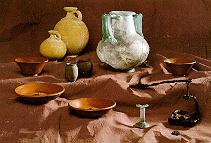 Sometime after 5000 BC a new economy and new technology including pottery
begin to appear. The Neolithic or New Stone Age as it is called features a much
more sophisticated toolkit of flint with blades, knives, scrapers and other flake
tools, together with leaf-shaped arrowheads. People were now farming:
domesticating animals, growing crops. Permanent settlements now appear for the
first time, and we can even see trade links emerging. Stone axes made in
Cornwall, Wales and Cumbria have been found locally and a massive flint mine
at Grimes Graves was exporting flint far and wide by 2600 BC. One of the earliest
known farmsteads in Britain, dating from around 3500 BC, was found at Hurst
Fen, Mildenhall. Evidence is now appearing for the first time to distinguish the
"haves" from the "have-nots": high status burial rites must have been for a tiny
élite; purely symbolic instruments of power like "mace-heads" are now made and
used.
Sometime after 5000 BC a new economy and new technology including pottery
begin to appear. The Neolithic or New Stone Age as it is called features a much
more sophisticated toolkit of flint with blades, knives, scrapers and other flake
tools, together with leaf-shaped arrowheads. People were now farming:
domesticating animals, growing crops. Permanent settlements now appear for the
first time, and we can even see trade links emerging. Stone axes made in
Cornwall, Wales and Cumbria have been found locally and a massive flint mine
at Grimes Graves was exporting flint far and wide by 2600 BC. One of the earliest
known farmsteads in Britain, dating from around 3500 BC, was found at Hurst
Fen, Mildenhall. Evidence is now appearing for the first time to distinguish the
"haves" from the "have-nots": high status burial rites must have been for a tiny
élite; purely symbolic instruments of power like "mace-heads" are now made and
used.


